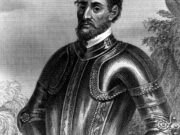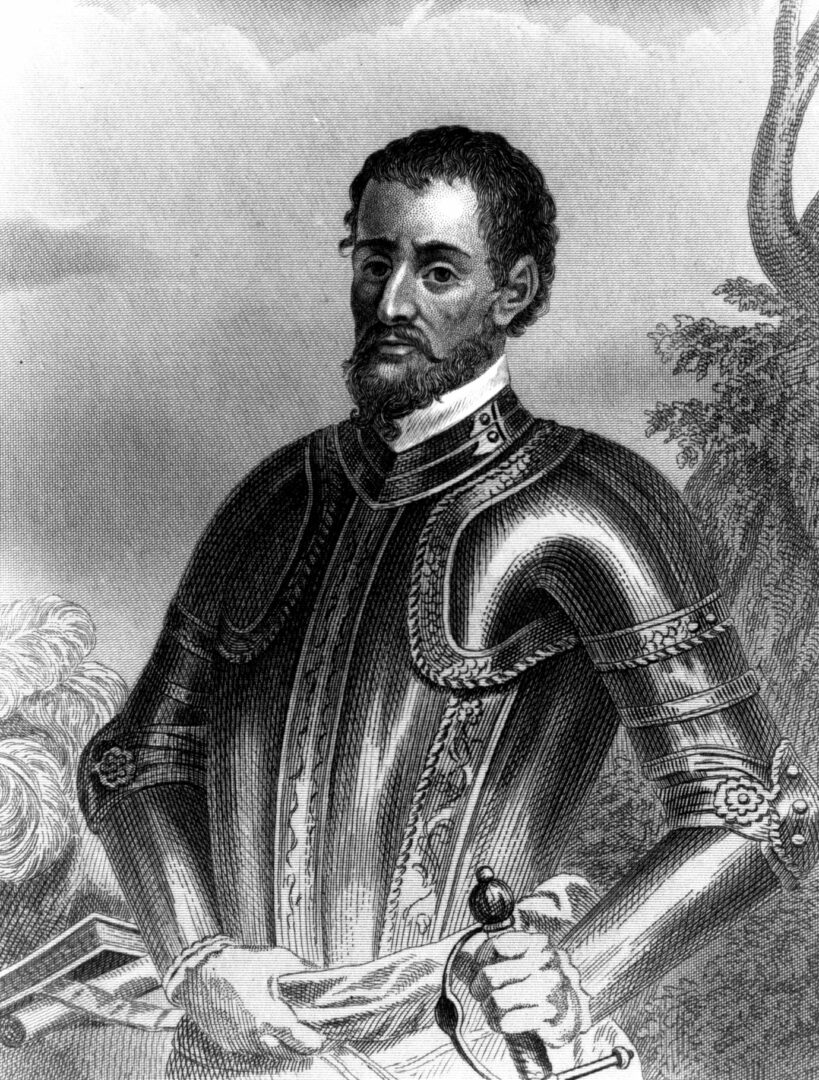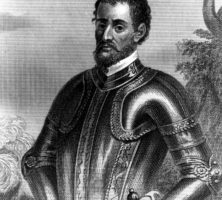The first European to explore the interior of what is now the state of Georgia was Hernando de Soto. In fact, De Soto entered the state on two occasions during the course of his expedition.
Hernando de Soto was born about the year 1500 in Extremadura, Spain. As a very young man he participated in the conquest of Panama and Nicaragua, and later he played a major role in the conquest of the Incas in Peru, where he became immensely wealthy. Not content with mere riches, De Soto wanted to be socially elevated to a marquis, the equal of the Spanish conquistador Francisco Pizarro. He returned to Spain, and in 1537 Charles V granted him the right to explore and conquer La Florida, a territory whose only known borders at that time were the lower Atlantic coast and peninsular Florida. The nature and extent of the interior (present-day North America) were completely unknown at the time.
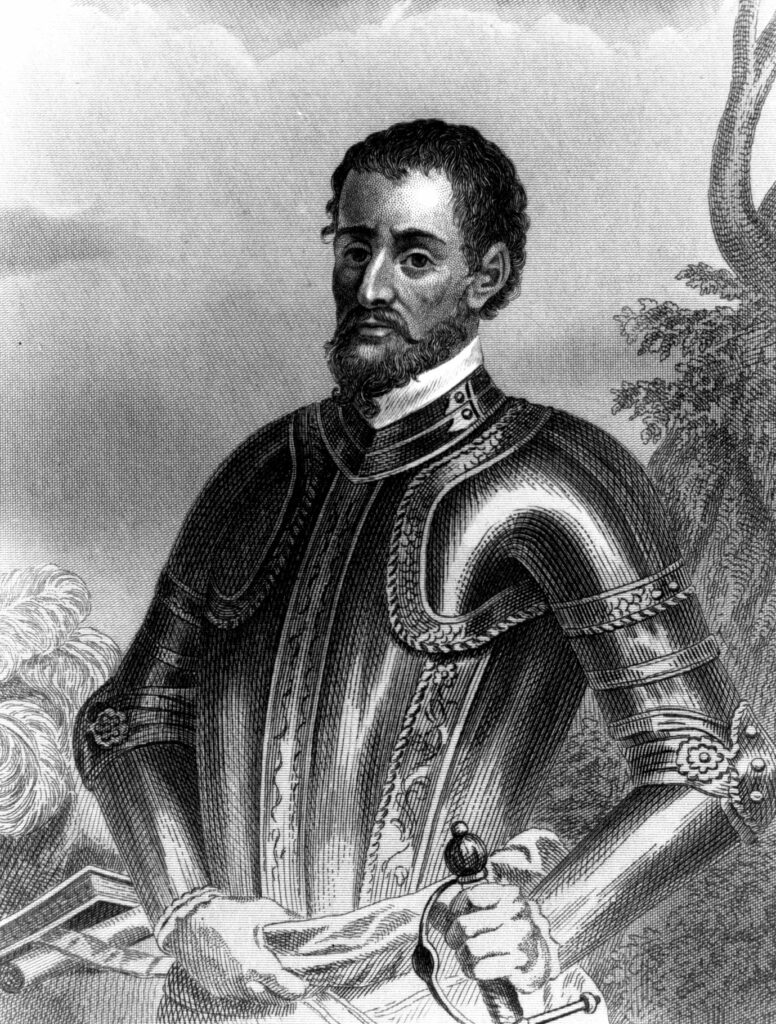
Courtesy of Georgia Info, Digital Library of Georgia.
De Soto’s fleet sighted the western coast of Florida near Tampa Bay on May 25, 1539. He landed with about 600 men and about 220 horses, and from there he proceeded northward to present-day Tallahassee, where he and his men spent the winter of 1539-40 in the territory of the chiefdom of Apalachee.
On March 3, 1540, De Soto and his army departed from Apalachee. By day’s end they had reached just inside the southern border of what is now Georgia, a few miles south of present-day Cairo. When they reached the Flint River, they built a crude boat and ferried everyone to the western side of the river. From there they proceeded to the Chickasawhatchee Swamp, where they came to the chiefdom of Capachequi.
After spending six days in Capachequi, they resumed traveling northeast, proceeding up the western side of the Flint River to near present-day Montezuma, where they crossed to the eastern side of the river and came to the chiefdom of Toa on March 23. After a short stay, they continued on to the northeast until they came to the Ocmulgee River. In an abandoned village on an island in the Ocmulgee, De Soto’s company discovered meat left roasting on a barbacoa, a wooden frame suspended over a wood fire. This is the first recorded instance of barbecue in Georgia. They proceeded upstream a few miles until they came to the chiefdom of Ichisi, whose main town is thought to have been at the Lamar mound site at present-day Macon. Because the people of Ichisi met them peacefully, De Soto ordered that a wooden cross be set atop a mound in the town, and De Soto and his men tried to explain its significance to the Indians.
From Ichisi they proceeded northeast to the Oconee River, where they found the chiefdoms of Altamaha, Ocute, and Patofa. The chiefdom of Ocute was the most powerful of these three. From Ocute they continued eastward, crossing the Savannah River several miles north of where Augusta now lies. They continued through present-day South Carolina and North Carolina before turning northward to cross the Appalachian Mountains, entering the Tennessee Valley east of what is now Newport, Tennessee.
Then, proceeding westward down the Tennessee Valley, they entered Georgia for the second time around July 15, 1540. On July 16 they came to the principal town of the chiefdom of Coosa at the Little Egypt archaeological site, now submerged beneath Carters Lake. Like the chief of Ocute, the chief of Coosa was a particularly powerful one, with influence over chiefdoms to the northeast as far as present-day Knoxville and Newport, Tennessee, and to the southwest as far as about Childersburg, Alabama. When De Soto and his army approached the capital town, the chief of Coosa was carried out on a palanquin (a covered couch) borne upon the shoulders of his retainers, while other retainers walked along singing and playing flutes.
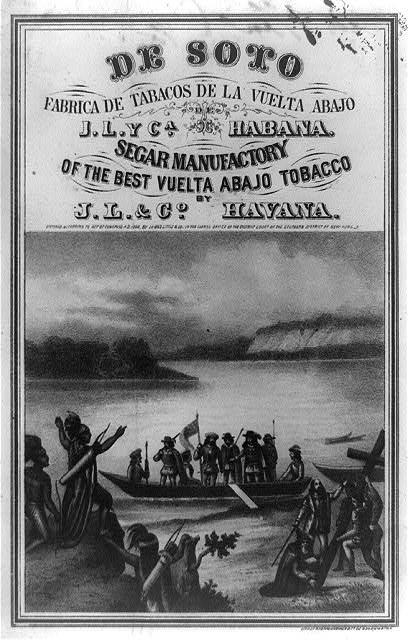
Courtesy of Library of Congress, Prints and Photographs Division
On August 20, 1540, De Soto and his army departed from the main town of Coosa and traveled to the south, crossing the Etowah River at the town of Itaba—the Etowah Mound site—and proceeding onto the chiefdom of Ulibahali at present-day Rome. They continued down the Coosa River to another town, perhaps Apica, possibly located at the King site in Foster’s Bend. On September 5, 1540, they crossed into what is now the state of Alabama.
The expedition continued westward for another three years. During this time about half of the original army were killed by Indians or died of various causes, as did De Soto himself.
Within a few years of De Soto’s visit, the powerful chiefdoms that he had encountered began to collapse. Archaeologists believe that this collapse was due in part to population loss from European diseases for which Native Americans lacked immunity, such as smallpox and measles. De Soto is also thought to have been instrumental in creating a long-lasting hostile relationship between Native American tribes and Europeans. Even before De Soto arrived in La Florida, he was known for employing such harsh methods as kidnapping Native Americans to use as guides and holding Native American women and children hostage in exchange for supplies.
Two historical markers commemorate Hernando de Soto’s time in Georgia: one along the Riverwalk in Augusta, and the other at the tourism office in Milledgeville.


